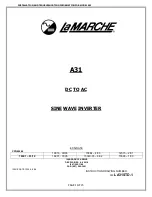
SFC6400A/SFC1450A Synthesized Frequency Upconverter
User Interfaces
TM106 – Rev. 1.1
4-19
Long-term stability of the reference is affected by factors
other than temperature. Over days and months, the
frequency of the reference will drift at a rate specified as
aging. Typical aging rates of 1 to 5 parts in 10
-10
per day
are typical in a crystal that has been stabilized for a few
weeks. The first month of operation for any crystal is a
time where drift due to aging can be excessive.
The typical aging curve provides insight into the
exponential decay in aging rate for a 10 MHz Reference.
Converters shipped from the factory have had their
reference oscillator aged for a minimum of 30 days and in
addition, the aging rate has been verified in the final week
to within tolerance. However, converters that have been in
storage or powered off for a period of several weeks will
exhibit a phenomenon whereby the aging curve return to
the slope shown for zero days of aging. This aging reset
in not well understood but the manufacturers of crystals
believe it to be related to a gradual relaxation of the
molecular makeup of the quartz substrates and the
conductive films deposited on the quartz.
The rule of thumb when checking the frequency accuracy
of the converter is to make sure that the crystal has
stabilized before attempting any adjustment. For units
that have been in storage or shipment for more than a
week, allow several days of operation before verifying the
accuracy. For this reason, converters shipped from
Radyne ComStream Corporation are typically powered-up
until the final day before shipment. In addition, the
accuracy and aging rate are verified immediately prior to
shipment.
For a converter that has been powered-up for several
months, the operator can assume an aging rate of several
ppb per month. If the aging rate has been established,
the station operator can make calculated adjustments
from the reference offset Menu at timed intervals.
LED TEST:
{OFF, ON}
Allows the user to test the function of all front panel LEDs.
All of the LEDs will cycle on and off except the Power
LED, which is always lit when power is on.
Summary of Contents for SFC6400A
Page 2: ......
Page 14: ...Introduction SFC6400A SFC1450A Synthesized Frequency Upconverter 1 2 TM106 Rev 1 1 ...
Page 41: ...User Interfaces SFC6400A SFC1450A Synthesized Frequency Upconverter 4 18 TM106 Rev 1 1 ...
Page 61: ...User Interfaces SFC6400A SFC1450A Synthesized Frequency Upconverter 4 38 TM106 Rev 1 1 ...
Page 64: ...SFC6400A SFC1450A Synthesized Frequency Upconverter User Interfaces TM106 Rev 1 1 4 41 ...
Page 67: ...User Interfaces SFC6400A SFC1450A Synthesized Frequency Upconverter 4 44 TM106 Rev 1 1 ...
Page 82: ...Rear Panel Interfaces SFC6400A SFC1450A Synthesized Frequency Upconverter 5 10 TM106 Rev 1 1 ...
Page 96: ...Appendix A SFC6400A SFC1450A Synthesized Frequency Upconverter A 6 TM106 Rev 1 1 ...
Page 106: ...Appendix A SFC6400A SFC1450A Synthesized Frequency Upconverter A 16 TM106 Rev 1 1 ...
Page 117: ...SFC6400A SFC1450A Synthesized Frequency Upconverter Appendix A TM106 Rev 1 1 A 27 ...
Page 148: ...SFC6400A SFC1450A Synthesized Frequency Upconverter Appendix C TM106 Rev 1 1 C 19 END ...
Page 149: ...Appendix C SFC6400A SFC1450A Synthesized Frequency Upconverter C 20 TM106 Rev 1 1 ...
Page 156: ...SFC6400A SFC1450A Synthesized Frequency Upconverter Glossary TM106 Rev 1 1 G 7 ...
















































